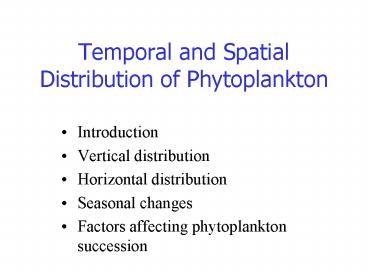Temporal and Spatial Distribution of Phytoplankton - PowerPoint PPT Presentation
1 / 24
Title:
Temporal and Spatial Distribution of Phytoplankton
Description:
'Paradox of the plankton' Possible explanations: Niche diversification due to: ... Time scale in plankton populations relative to their reproductive period ... – PowerPoint PPT presentation
Number of Views:492
Avg rating:3.0/5.0
Title: Temporal and Spatial Distribution of Phytoplankton
1
Temporal and Spatial Distribution of Phytoplankton
- Introduction
- Vertical distribution
- Horizontal distribution
- Seasonal changes
- Factors affecting phytoplankton succession
2
Introduction
- Aquatic vs. terrestrial plant distribution
- Review of terminology
- seston
- plankton
- nekton
- plant communities
3
Size classes of plankton
- ultraplankton lt 10 µm
- nanoplankton lt 67 µm
- net plankton gt 67 µm
4
Spatial Distribution of Plankton
- Vertical distribution
- Passive Movement Sinking!
- Archimedes Principle
- F gkd3 (p'-p)
- where p density of body
- p density of liquid
- g gravitational acceleration
- kd3 volume of the body, where
- d is a linear measurement
5
- Stokes Law
- the drag force on a sphere
- F 3 pµV0d
- where V0 velocity
- µ dynamic viscosity
- d diameter of sphere
6
- Therefore,
- sinking velocity slows viscosity ?
- sinking velocity slows excess density of the
- object over the medium ?
- sinking velocity slows radius2 ?
7
- Vertical distribution affected by
- specific gravity adjustments
- - oil and gas vacuoles
- - ex blue-green algae
- - selective accumulation of ions
- - ex green algae
8
- 2. Form resistance e.g. orthogonal projections
- - ex centric diatoms
- 3. Size
- - microplankton settle slowly!
9
- 4. Water movement, calm vs. wind-mixed
distribution
10
- Active movement
- Vertical migration
- Ex flagellates
- Phototaxis
- Positive- movement towards the light
- Negative- movement away from the light
- Geotaxis
- Resistance to sinking, ex zooplankton
Horizontal Concentrations
11
Seasonal Changes in Phytoplankton Populations
- Factors increasing phytoplankton numbers
- Favorable changes in temperature
- " " light
- " " nutrients
- Each species of algae has a range of tolerance to
environmental extremes growth and reproduction
is enhanced by optimal combinations of these
factors
12
- Factors decreasing phytoplankton numbers
- Grazing by zooplankton (and some fish)
- Depletion of nutrients
- Parasitism, e.g. fungi, competition for resources
13
- Sedimentation
- Unfavorable light, temperature, etc.
- Toxins produced by other phytoplankton
14
Factors affecting phytoplankton succession or the
relative abundance of species include
- Light and Temperature
15
Temperature Requirements of Phytoplankton
- Oligothermal cold requiring
- Ex trout
- Polythermal warm requiring
- Ex tilapia
- Eurythermal tolerant of wide temperature ranges
- Ex carp, catfish
16
- Turbulence
- Ex streams or waves over periphyton
- Concentration of nutrients
- Ex end of diatom maximum due to silica depletion
- Ex succession of phytoplankton species
17
(No Transcript)
18
- Growth promoting and growth inhibiting substances
and nutrient competition - Blue-greens can produce a factor which inhibits
growth of other algae - Aquatic macrophytes may also inhibit algal growth
by shading out phytoplankton and competing for
available nutrients - Metabolites and anti-metabolites
19
(No Transcript)
20
Polar vs. Temperate vs. Tropical
Little winter growth, large seasonal amplitude
Small seasonal variation
21
- Polar Lakes
- A single peak usually occurs in mid-summer
- Temperate Lakes
- Increase in total biomass in early spring due to
increased light, max in April, then decline - Second max (usually smaller), maybe in autumn due
to increased water circulation (i.e. nutrient
supply)
22
Phytoplankton Community Ecology
- Paradox of the plankton
- Possible explanations
- Niche diversification due to
- Physical niche diversification
- Predation
- Commensalisms and symbiosis
- Differences in resource utilization efficiencies
23
- Theory of the temporal niche
- Phytoplankton have relatively low competition
coefficients - Phytoplankton reproduce rapidly
- Physical factors change through time
- Time scale in plankton populations relative to
their reproductive period - Non-equilibrium community
- Theory of recruitment from littoral flora
24
(No Transcript)































